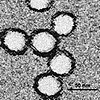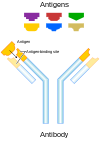Video:West Nile fever
| West Nile fever (Tutorial) | |
|---|---|
| On Commons | |
| Steps for video creation | |
| Step 1 | Preview my changes (10 sec) |
| Step 2 | Upload to Commons (10 min) |
Definition
West Nile fever is an infection by the West Nile virus, which is typically spread by mosquitoes.[1] In about 80 percent of infections people have few or no symptoms.[2] About 20 percent of people develop a fever, headache, vomiting, or a rash.[1] It was discovered in Uganda in 1937, and was first detected in North America in 1999.[1][3]

Signs and symptoms
Most people with mild symptoms of WNV recover completely, though fatigue and weakness may last for weeks or months. Symptoms may range from mild, such as fever, to severe, such as paralysis and meningitis. A severe infection can last weeks and can, rarely, cause permanent brain damage. Death may ensue if the central nervous system is affected.[4][5]

Virology
Image reconstructions and cryoelectron microscopy reveal a 45 to 50 nanometer virion covered with a relatively smooth protein surface. This structure is similar to the dengue fever virus; both belong to the genus Flavivirus within the family Flaviviridae. The genetic material of WNV is a positive-sense, single strand of RNA, which is between eleven thousand and twelve thousand nucleotides long; these genes encode seven nonstructural proteins and three structural proteins. [6]

Transmission
The prime method of spread of the West Nile virus is the female mosquito. In Europe, cats were identified as being hosts for West Nile virus.[7] The important mosquito vectors vary according to area; in the United States, Culex pipiens, Culex tarsalis, and Culex quinquefasciatus are the main vector species.[8]

Risk factors
Risk factors independently associated with developing a clinical infection with WNV include a suppressed immune system and a medical history of organ transplantation.[9] For neuroinvasive disease the additional risk factors include older age meaning older than 50, hypertension, and diabetes mellitus.[10][11]

Diagnosis
Definitive diagnosis of WNV is obtained through detection of virus-specific antibody IgM and neutralizing antibodies. Cases of West Nile virus meningitis and encephalitis that have been serologically confirmed produce similar degrees of CSF pleocytosis and are often associated with substantial CSF neutrophilia.[12]

Prevention
Many of the guidelines for preventing occupational West Nile virus exposure are common to all mosquito-borne diseases. One should have insect repellant, long sleeve shirt, and use mosquito nets, to name but a few of the preventive measures.[13]

Monitoring
West Nile virus can be sampled from the environment by the pooling of trapped mosquitoes via , carbon dioxide-baited light traps;[14] testing of the mosquito samples requires the use of reverse-transcriptase PCR to directly amplify and show the presence of the virus in the submitted samples.[15]

Treatment
No specific treatment is available for WNV infection. Most people recover without treatment. In mild cases, over-the-counter pain relievers can help ease mild headaches and muscle aches in adults. In severe cases supportive care is provided, often in hospital, with intravenous fluids, pain medication, and respiratory support.[16]

Prognosis
While the general prognosis is favorable, current studies indicate that West Nile fever can often be more severe than previously recognized, with studies of various recent outbreaks indicating that it may take as long as 60 to 90 days to recover.[17][18]

Epidemiology 1
WNV was first isolated from a feverish 37 year old woman at Omogo in the West Nile District of Uganda in 1937 during research on Yellow fever virus.[19] A series of serosurveys in 1939 in central Africa found anti-WNV positive results ranging from 1 (point) 4 percent in Congo to 46 (point) 4 percent in White Nile region, Sudan.[20]

Epidemiology 2
The first appearance of WNV in the Western Hemisphere was in 1999[21] with encephalitis reported in humans, dogs, cats, and horses, and the subsequent spread in the United States.

References
- ↑ 1.0 1.1 1.2 "General Questions About West Nile Virus". www.cdc.gov. 19 October 2017. Archived from the original on 26 October 2017. Retrieved 26 October 2017.
- ↑ "Symptoms, Diagnosis, & Treatment". www.cdc.gov. 15 January 2019. Archived from the original on 26 October 2017. Retrieved 15 January 2019.
- ↑ "West Nile virus". www.who.int. Retrieved 9 April 2022.
- ↑ "Symptoms, Diagnosis, & Treatment". Centers for Disease Control and Prevention. USA.gov. 2018-12-10. Archived from the original on 2017-10-26. Retrieved 15 January 2019.
- ↑ "West Nile virus". Mayoclinic. Mayo Foundation for Medical Education and Research (MFMER). Archived from the original on 21 July 2019. Retrieved 15 January 2019.
- ↑ Rossi, Shannan L.; Ross, Ted M.; Evans, Jared D. (2010). "West Nile Virus". Clinics in laboratory medicine. 30 (1): 47–65. doi:10.1016/j.cll.2009.10.006. ISSN 0272-2712. Archived from the original on 11 April 2022. Retrieved 10 April 2022.
- ↑ Rijks, J.M.; Cito, F.; Cunningham, A.A.; Rantsios, A.T.; Giovannini, A. (2016). "Disease Risk Assessments Involving Companion Animals: an Overview for 15 Selected Pathogens Taking a European Perspective". Journal of Comparative Pathology. 155 (1): S75–S97. doi:10.1016/j.jcpa.2015.08.003. ISSN 0021-9975. PMID 26422413.
- ↑ Hayes EB, Komar N, Nasci RS, Montgomery SP, O'Leary DR, Campbell GL (2005). "Epidemiology and transmission dynamics of West Nile virus disease". Emerging Infect. Dis. 11 (8): 1167–73. doi:10.3201/eid1108.050289a. PMC 3320478. PMID 16102302.
- ↑ Kumar D, Drebot MA, Wong SJ, et al. (2004). "A seroprevalence study of West Nile virus infection in solid organ transplant recipients". Am. J. Transplant. 4 (11): 1883–8. doi:10.1111/j.1600-6143.2004.00592.x. PMID 15476490. S2CID 31695008.
- ↑ Jean CM, Honarmand S, Louie JK, Glaser CA (December 2007). "Risk factors for West Nile virus neuroinvasive disease, California, 2005". Emerging Infect. Dis. 13 (12): 1918–20. doi:10.3201/eid1312.061265. PMC 2876738. PMID 18258047.
- ↑ Kumar D, Drebot MA, Wong SJ, et al. (2004). "A seroprevalence study of west nile virus infection in solid organ transplant recipients". Am. J. Transplant. 4 (11): 1883–8. doi:10.1111/j.1600-6143.2004.00592.x. PMID 15476490. S2CID 31695008.
- ↑ Tyler KL, Pape J, Goody RJ, Corkill M, Kleinschmidt-DeMasters BK (February 2006). "CSF findings in 250 patients with serologically confirmed West Nile virus meningitis and encephalitis". Neurology. 66 (3): 361–5. doi:10.1212/01.wnl.0000195890.70898.1f. PMID 16382032. S2CID 37751889.
- ↑ "Prevention | West Nile Virus | CDC". www.cdc.gov. 2018-09-24. Archived from the original on 2020-08-21. Retrieved 2018-11-28.
- ↑ Roiz, David; Roussel, Marion; Muñoz, Joaquin; Ruiz, Santiago; Soriguer, Ramón; Figuerola, Jordi (1 April 2012). "Efficacy of Mosquito Traps for Collecting Potential West Nile Mosquito Vectors in a Natural Mediterranean Wetland". The American Journal of Tropical Medicine and Hygiene. 86 (4): 642–648. doi:10.4269/ajtmh.2012.11-0326. ISSN 0002-9637. Retrieved 17 April 2022.
- ↑ Jozan, M; Evans R; McLean R; Hall R; Tangredi B; Reed L; Scott J (Fall 2003). "Detection of West Nile virus infection in birds in the United States by blocking ELISA and immunohistochemistry". Vector-Borne and Zoonotic Diseases (Submitted manuscript). 3 (3): 99–110. doi:10.1089/153036603768395799. PMID 14511579. Archived from the original on 2020-07-23. Retrieved 2018-11-07.
- ↑ "Treatment & Prevention | West Nile Virus | CDC". www.cdc.gov. 10 November 2021. Archived from the original on 22 November 2021. Retrieved 12 April 2022.
- ↑ Carson, Paul J.; Konewko, Patrick; Wold, Kimberly S.; Mariani, Paul; Goli, Sunil; Bergloff, Paula; Crosby, Ross D. (15 September 2006). "Long-term clinical and neuropsychological outcomes of West Nile virus infection". Clinical Infectious Diseases: An Official Publication of the Infectious Diseases Society of America. 43 (6): 723–730. doi:10.1086/506939. ISSN 1537-6591. Retrieved 17 April 2022.
- ↑ Watson JT, Pertel PE, Jones RC, et al. (September 2004). "Clinical characteristics and functional outcomes of West Nile Fever". Ann. Intern. Med. 141 (5): 360–5. doi:10.7326/0003-4819-141-5-200409070-00010. PMID 15353427. S2CID 5779034.
- ↑ Smithburn KC, Hughes TP, Burke AW, Paul JH (June 1940). "A Neurotropic Virus Isolated from the Blood of a Native of Uganda". Am. J. Trop. Med. 20 (1): 471–92. doi:10.4269/ajtmh.1940.s1-20.471.
- ↑ Work TH, Hurlbut HS, Taylor RM (1953). "Isolation of West Nile virus from hooded crow and rock pigeon in the Nile delta". Proc. Soc. Exp. Biol. Med. 84 (3): 719–22. doi:10.3181/00379727-84-20764. PMID 13134268. S2CID 45962741.
- ↑ Nash D, Mostashari F, Fine A, et al. (June 2001). "The outbreak of West Nile virus infection in the New York City area in 1999". N. Engl. J. Med. 344 (24): 1807–14. doi:10.1056/NEJM200106143442401. PMID 11407341. Archived from the original on 2020-06-10. Retrieved 2019-07-03.